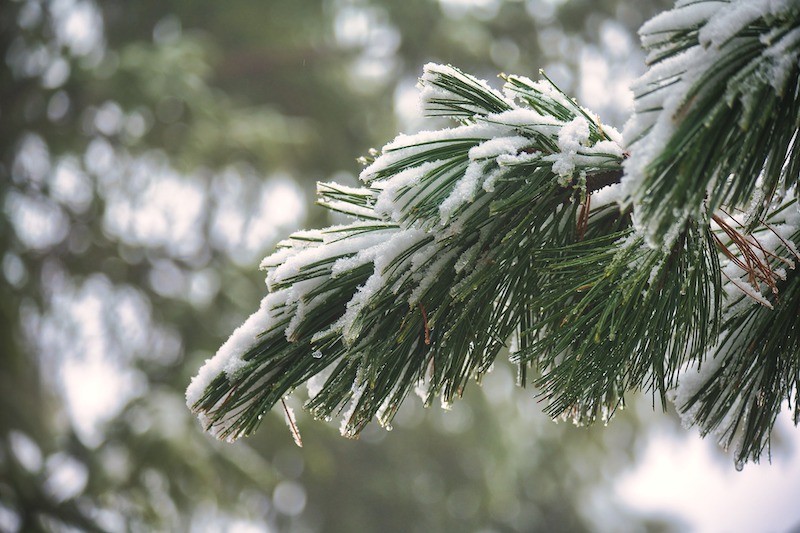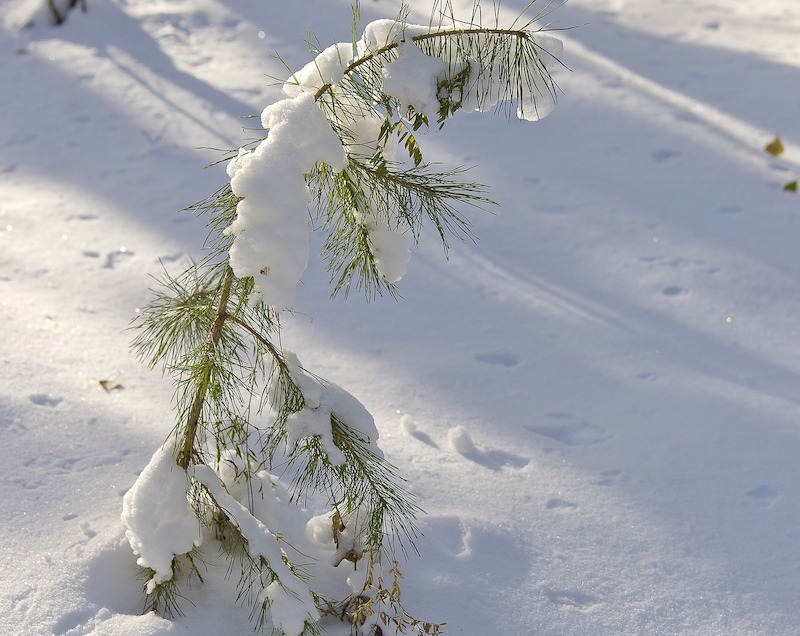Pine trees, Pinus sp., are cold-hardy plants suitable for USDA zones 2-9, depending on the species. Unlike many other plants, pine trees and other evergreens do not go completely dormant during winter. Instead, they experience slowed growth, and their needles will continue to transpire, which creates the potential for winter damage. Preparing and protecting your pine trees for winter will ensure that you have healthy plants come spring.

Protecting Pine Trees in Winter
Winter burn is a common problem for pine trees. Needles will turn brown and dry, especially on parts of the tree facing south or west. Newly planted trees and trees with poorly developed root systems are at the highest risk of winter burn. This condition usually occurs due to desiccation of the needles as they transpire through winter, losing water faster than the roots can uptake it. Frozen ground, sunny or windy exposure, salty soils, and seasonally colder temperatures increase the chance of winter burn. Most of the time, symptoms will not be apparent until winter ends. If severe enough, entire trees may die.
Cutting Back Pine Trees For Winter
Pine trees do not need to be pruned for winter unless there are dead or damaged branches that need to be removed. In fact, pruning pine trees later in the season does not provide enough time for wounds to heal before cold temperatures hit. This makes them more prone to winter damage, pests, diseases, and stress.
Pine Tree Winter Care in Pots
Growing pine trees in containers makes the roots more susceptible to winter damage. The best thing to do when growing outdoor plants in containers is to select species that are winter hardy to at least one zone below your growing zone, as these plants can handle lower minimum temperatures. For example, if you live in zone 7 and wish to grow pine trees in containers, opt for species that are hardy to zones 6, 5, 4, or less. Potted pine trees can be moved to an unheated garage or shed for extra winter protection. This can be very helpful for container-grown seedlings and younger trees that have not yet developed strong root systems.
Watering Pine Trees in Winter
Watering pine trees properly is perhaps the most important way to protect them in winter. It is very important that the soil maintains adequate moisture throughout winter to prevent winter burn in pine trees. Water them deeply in fall before cold weather hits, and water after as needed whenever the soil is not frozen or already moist. Pine trees can be watered throughout winter on any day that temperatures are above 40 degrees F. Mulching can also help the soil conserve moisture.

Growing Pine Trees Indoors
While pine trees do not go fully dormant over winter, it is not recommended to keep them indoors through winter. The majority of pines are native to temperate regions, and have evolved to grow based on seasonal cues such as temperature and light. Bringing pine trees indoors for extended periods of time can cause stress to the plant. If the pine tree is growing within its hardiness zone, it will do fine outside with proper care and preparation.
Steps To Care For Pine Trees in Winter
Preparing pine trees for winter is a process that starts early in the season. A pine tree that is well cared for throughout all seasons is a pine tree that thrives in winter. Be sure that your pine trees have consistent moisture year-round to prevent winter burn and dieback.
Step 1 - Water pine trees deeply throughout spring, summer, and fall during periods of drought. Newly planted and younger pine trees will need to be watered more often – one or more times a week – to establish healthy roots.
Step 2 - Water deeply in winter whenever temperatures are above 40 degrees F and the ground is not frozen.
Step 3 - Apply mulch to help insulate the soil surrounding the pine tree. Evenly spread 3-4 inches of mulch over the tree’s root system, avoiding the trunk of the tree to prevent rot.
Step 4 - Burlap and other tree coverings are available to protect pine trees from harsh winter conditions. Do not tightly wrap trees with protective coverings; rather, install them by wrapping them around stakes surrounding the pine tree.
Step 5 - Avoid applying salt for ice near pine trees, as this can increase the risk of winter burn. Furthermore, do not remove snow from the soil or branches of mature pine trees. Snow acts as an insulator for soil and can provide much-needed moisture to the tree as it melts. Snow on branches of pine trees can help protect them from winter burn, shielding the needles from the sun and wind. Heavy, wet snow on younger branches can cause damage and should be removed.
Step 6 - Do not fertilize late in summer or fall, as this can cause bursts of new growth that are highly susceptible to winter damage. Fertilize pine trees in the spring only.
Step 7 - Prune out any branches damaged by winter burn in the spring.
 |
Lauren Youngcourt - Published 03-25-2023 |
